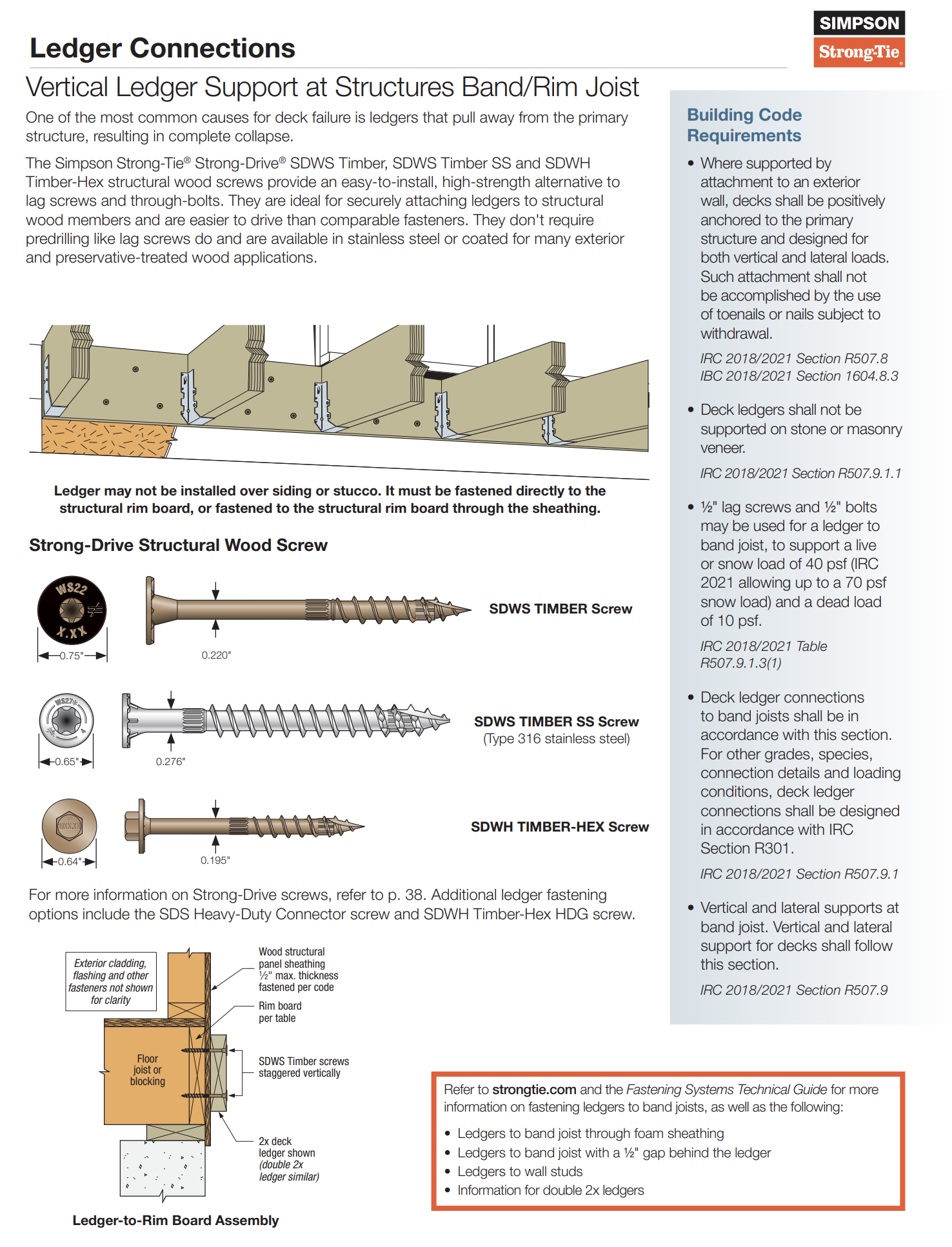Deck ledger connections are a critical component in deck construction. A properly installed ledger ensures the deck remains securely attached to the primary structure, preventing potential failures and collapses. This blog will explore the importance of deck ledger connections, building code requirements, and solutions from Simpson Strong-Tie for secure and compliant installations.
The Importance of Secure Deck Ledger Connections
One of the most common causes of deck failure is the ledger pulling away from the primary structure. This can lead to a complete collapse, posing serious safety risks. Ensuring that the ledger is securely fastened to the structural wood members of the building is vital for both the safety and longevity of the deck.
Simpson Strong-Tie Solutions for Ledger Connections
Strong-Drive® SDWS Timber, SDWS Timber SS, and SDWH Timber-Hex Screws
Simpson Strong-Tie offers high-strength alternatives to lag screws and through-bolts for ledger connections. These screws are designed to securely attach ledgers to structural wood members, providing easy installation and robust performance without the need for predrilling.
- SDWS Timber SS Screw: Made of Type 316 stainless steel, ideal for exterior and preservative-treated wood applications.
Ledger Connection Applications
- Ledgers to Band Joist Through Foam Sheathing
- Ledgers to Band Joist with a 1/2″ Gap Behind the Ledger
- Ledgers to Wall Studs
- Double 2x Ledgers
Important Note: Ledgers must not be installed over siding or stucco. They must be fastened directly to the structural rim board, or through the sheathing to the rim board.
Building Code Requirements for Ledger Connections
Positive Attachment to Primary Structure
Decks must be positively anchored to the primary structure, designed for both vertical and lateral loads. The use of toenails or nails subject to withdrawal is prohibited.
- IRC 2018/2021 Section R507.8
- IBC 2018/2021 Section 1604.8.3
Prohibition of Masonry Veneer Support
Deck ledgers cannot be supported on stone or masonry veneer.
- IRC 2018/2021 Section R507.9.1.1
Fastener Specifications
1/2″ lag screws and 1/2″ bolts can be used for ledger to band joist connections to support live or snow loads.
- IRC 2018/2021 Table R507.9.1.3(1)
Vertical and Lateral Supports
Vertical and lateral support for decks must follow specific code sections.
- IRC 2018/2021 Section R507.9
Specialized Solutions for Various Ledger Connections
BVLZ Brick Veneer Ledger Connector
The BVLZ brick veneer ledger connector offers a tested, code-compliant solution for attaching a deck ledger to a house with masonry veneer exterior. It avoids loading the veneer, adhering to building codes, and provides a viable alternative to building a freestanding deck.
- Components: Steel ledger plate, compression strut, installation guide, 14″ Strong-Drive SDWH Timber-Hex HDG tension screws, and Strong-Drive SD Connector shear screws.
Titen HD® SS Stainless-Steel Anchor
For attaching deck ledgers to concrete or grout-filled concrete masonry unit (GFCMU) walls, the Titen HD SS Stainless-Steel Anchor is recommended. Available in Type 304 or Type 316 stainless steel, it ensures secure and code-compliant connections.
Conclusion
Ensuring proper deck ledger connections is crucial for the safety and stability of your deck. By following building code requirements and using high-quality solutions from Simpson Strong-Tie, you can achieve a secure and compliant deck ledger installation. Always consult with a qualified professional to verify that your deck’s connections meet all necessary standards.
For immediate service or consultation, you may contact us at Allied Emergency Services, INC.
Contact Information:
- Phone: 1-800-792-0212
- Email: Info@AlliedEmergencyServices.com
- Location: Serving Illinois, Wisconsin, and Indiana with a focus on the greater Chicago area.
If you require immediate assistance or have specific questions, our human support is readily available to help you.
Disclaimer: This article is intended for informational purposes only. For professional advice, consult experts in the field.










